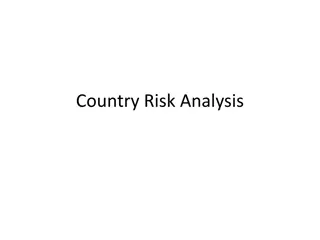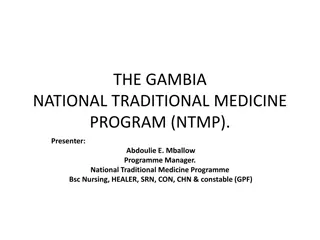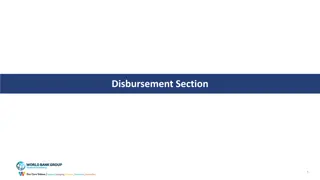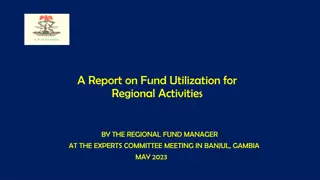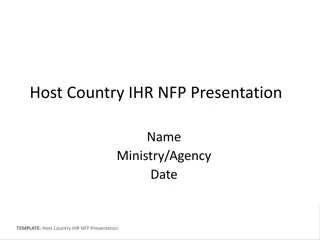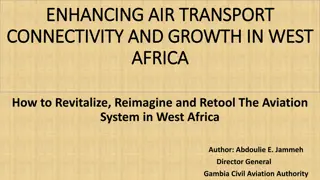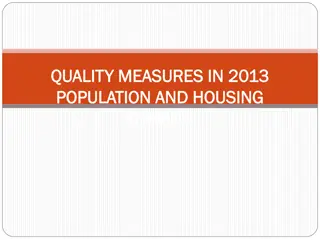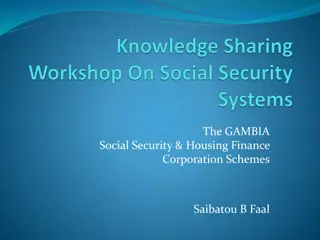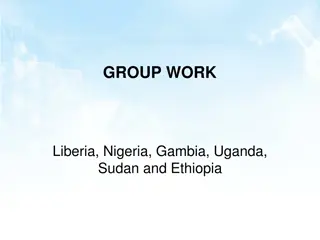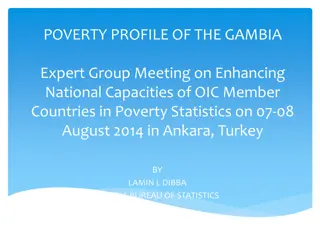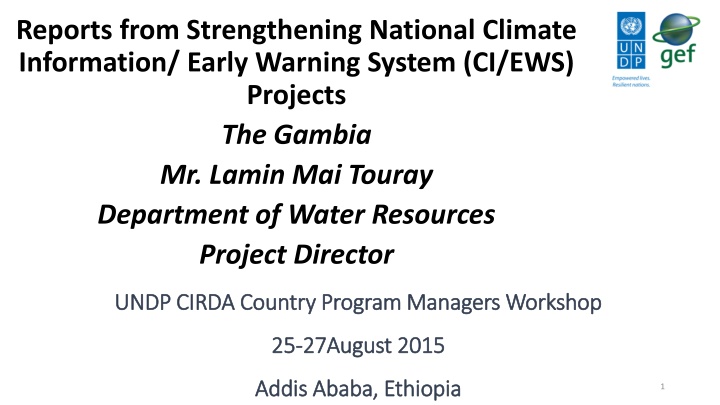
Strengthening National Climate Information and Early Warning System in The Gambia
Explore reports from the Strengthening National Climate Information and Early Warning System project in The Gambia, focusing on outcomes, key departments, and the project director's role in aligning phases and government mandates.
Download Presentation

Please find below an Image/Link to download the presentation.
The content on the website is provided AS IS for your information and personal use only. It may not be sold, licensed, or shared on other websites without obtaining consent from the author. If you encounter any issues during the download, it is possible that the publisher has removed the file from their server.
You are allowed to download the files provided on this website for personal or commercial use, subject to the condition that they are used lawfully. All files are the property of their respective owners.
The content on the website is provided AS IS for your information and personal use only. It may not be sold, licensed, or shared on other websites without obtaining consent from the author.
E N D
Presentation Transcript
Reports from Strengthening National Climate Information/ Early Warning System (CI/EWS) Projects The Gambia Mr. Lamin Mai Touray Department of Water Resources Project Director UNDP CIRDA Country Program Managers Workshop UNDP CIRDA Country Program Managers Workshop 25 25- -27August 2015 27August 2015 Addis Ababa, Ethiopia Addis Ababa, Ethiopia 1
Presentation Outline Introduction Project Organization Structure Key Departments/Agencies High Level View of Each Department/Agency Social, Economic Impact Future plans Challenges 2
Introduction 1. As the Project Director (PD) I should ensure a continued cohesion between the two phases of the project, as well as with the mandate of the DWR and provide additional linkages and interactions with high level policy components within the Government. 2. In this way, the DWR the lead agency will be in a good position to assume responsibility, on behalf of the GOTG, through the Ministry of Environment, Climate Change, Water, Forestry and Wildlife for successful implementation of the project. 3. Follow up on, supervise and coordinate the contributions of the GOTG
Outcomes The four complementary outcomes are: Outcome 1: The Gambia National Meteorological Services is supported in its transition to becoming a financially sustainable Meteorological Agency (supported by UNEP) Outcome 2: Hydrometeorological infrastructure is upgraded/installed and maintained that will cover the full needs for 'optimal performance of EWS' as identified by recent needs assessment reports in the Gambia (Supported by UNDP) Outcome 3: A critical mass of skilled human resources is able to operate the Gambia Early Warning System and perform medium and long-term climate adaptation planning beyond the project (supported by UNEP) Outcome 4: Efficient and effective use of hydro-meteorological and environmental information for making early warnings and long-term development plans (supported by UNEP)
Key Departments, Agencies or Services KEY STAKEHOLDERS ARE OF THREE CATEGORIES 1. Producers and Providers of Early Warning Products (e.g., the National Meteorological and Hydrological Services, and other related Services) 2. Communicators of Early Warning Products (NMHS, Media, MDFTs, Local Communicators (e.g., Kanyaleng, RLGs) 3. Users of Early Warning Products (All Stakeholders but particularly local communities)
Key Departments, Agencies or Services Key Stakeholders: The Multi-Disciplinary Facilitation Teams (MDFT), which operate in every Region as a structure that is responsible for extension service in the country. The Regional MDFT is composed of Extension Agents from all central government sectors (Agriculture, Livestock, Fisheries, Health, Water Resources, Environment, Forestry, Media/Communication (GRTS and Community Radios), etc), Civil Society (NGOs, CBOs, Women and Youth Groups, etc) and Local Government (Elected leaders, Local and Religious Leaders and Regional, District and Village Development Committees). These will act as key intermediaries among the national, regional and local levels. Wildlife and Biodiversity,
Key Government Stakeholders The following government stakeholders are key implementers and beneficiaries to the project in that they will receive/disseminate tailored advisories and communication messages, and based on their value added and basic abilities, they will also receive capacity building and skills development. Ministry of Environment, Climate Change, Water, Forestry and Wildlife; Ministry of Fisheries; Ministry of Agriculture; Ministry of Lands and Regional Government; Ministry of Finance and Economic Affairs; Ministry of Health and Social Welfare.
Key Government Stakeholders Stakeholders Outcomes Stakeholders will be involved in . Ministry of Environment, Climate Change, Water, Forestry and Wildlife 1, 2, 3 & 4 Ministry of Fisheries; 1 & 4 Ministry of Agriculture; 1 & 4 Ministry of Lands and Regional Government; 4 Ministry of Finance and Economic Affairs; 1 & 3 Ministry of Health and Social Welfare 4
Key Government Stakeholders Government Agencies that are key to the implementation of the Project include: National Environment Agency (NEA) National Disaster Management Agency (NDMA) Gambia Radio and Television (GRTS) Gambia Civil Aviation Authority (GCAA) Gambia Ports Authority (GPA)
Key Government Stakeholders Stakeholders Outcomes Stakeholders will be involved in 1, 2, 3 & 4 . National Environment Agency (NEA) National Disaster Management Agency (NDMA) 1 & 4 Gambia Radio and Television (GRTS) 4 Gambia Civil Aviation Authority (GCAA) 1 & 4 Gambia Ports Authority (GPA 1 & 4 Department of Parks and Wildlife Management 1 & 4
Key Government Stakeholders Civil Society Organizations (NGOs, CBOs) that will be fully involved in the projects include but not limited to: Community Radio Stations Kanyaleng Women s Groups TANGO Stay Green Foundation Famers Platform Radio Listening Groups WAWA Fansung Jamano Etc.
Key Government Stakeholders The Private Sector Gambia Chamber of Commerce and Industry (GCCI) is leading the engagement of the Private and Business Sector in Climate Change; A Climate Change Forum was initiated under Phase I and will be strengthened during this Phase
High Level View of Each Department/Agency Department of Water Resources provides the following services Meteorological Services Forecasting, service to aviation industry, disaster management, food security, research etc. Hydrological Services Water Resources Management, Monitoring River Level and Saline Front Technology currently deployed in support of operation Automatic Weather Stations (AWS) (3) expecting 9 AWS and 1 AWOS from ACPC and 7 AWS from UNDP, MSG Satellite Receiving Station (1). Automatic Water Level, Temperature and Conductivity Measurement Instrument (10), Ground Water Monitoring Instrument (OTT data-loggers) (37)
High Level View of Each Department/Agency Automated Hydrological Station at Sami Tenda/ Ballingho Automatic Weather Station in Keneba
High Level View of Each Department/Agency Observation Borehole at NAWEC Brikama Treatment Plant Surface Water Monitoring in Fatoto
Social, Economic Impact The following sectors are currently making use of the data/information Agriculture (Crop and Livestock), Health, Aviation, Disaster Management, Construction, Water Resources, Marine, Fishers etc. Access to this information is through Radio, Television, Print Media, Internet and Extension Workers
Future Plans Complete a market analysis to identify which services the new agency can provide and what possible fee management structure can be established Develop a cost-recovery overarching sustainable business plan, including list of hydro-met products, services, tariffs and prices for public and private clients policy and
Future Plans Develop a cost-benefit and economic model analysis for the new autonomous Met Agency and EWS Acquire flood forecasting software and hardware and provide training on flood modelling, flood forecasting and flood risk management Rehabilitate and repair the Bansang hydrological station which is the coordinating hub for all hydrological stations
Future Plans Conclude Environment, Climate Change, Water, Forestry and Wildlife and Ministry Communication Infrastructure and use of airwaves, radio frequencies and sustained broadcasting of weather, climate and climate early warning information on National Broadcasting Services (GRTS) and Community Radios Upgrade network of hydro-Meteorological stations a MOU between Ministry of of Information and
Challenges Late start of the Project The Project, which was set to start in August 2014 delayed till July 2015 (when PMU staff were appointed) and the first disbursement was not received until April 2015. Reasons for the delay in the appointment of the PMU staff are beyond the knowledge of the PMU as it was not in place at the time.
Challenges Motivation of political will to support project which if lacked could pose potential to limit sustainability Lack of coordination among government stakeholders may cause delay in implementation Unavailability of requisite skilled human capital could cause implementation delay or failure of project results
Challenges Inability to communicate effectively with local communities may lead to inadequate use of project products and limit sustainability Telecommunication challenges hamper implementation of the project which may lead to low level utilization of project investments Occurrence of extreme climate events may disrupt or damage project infrastructure
THANK YOU ALL FOR THANK YOU ALL FOR YOUR ATTENTION YOUR ATTENTION 24



